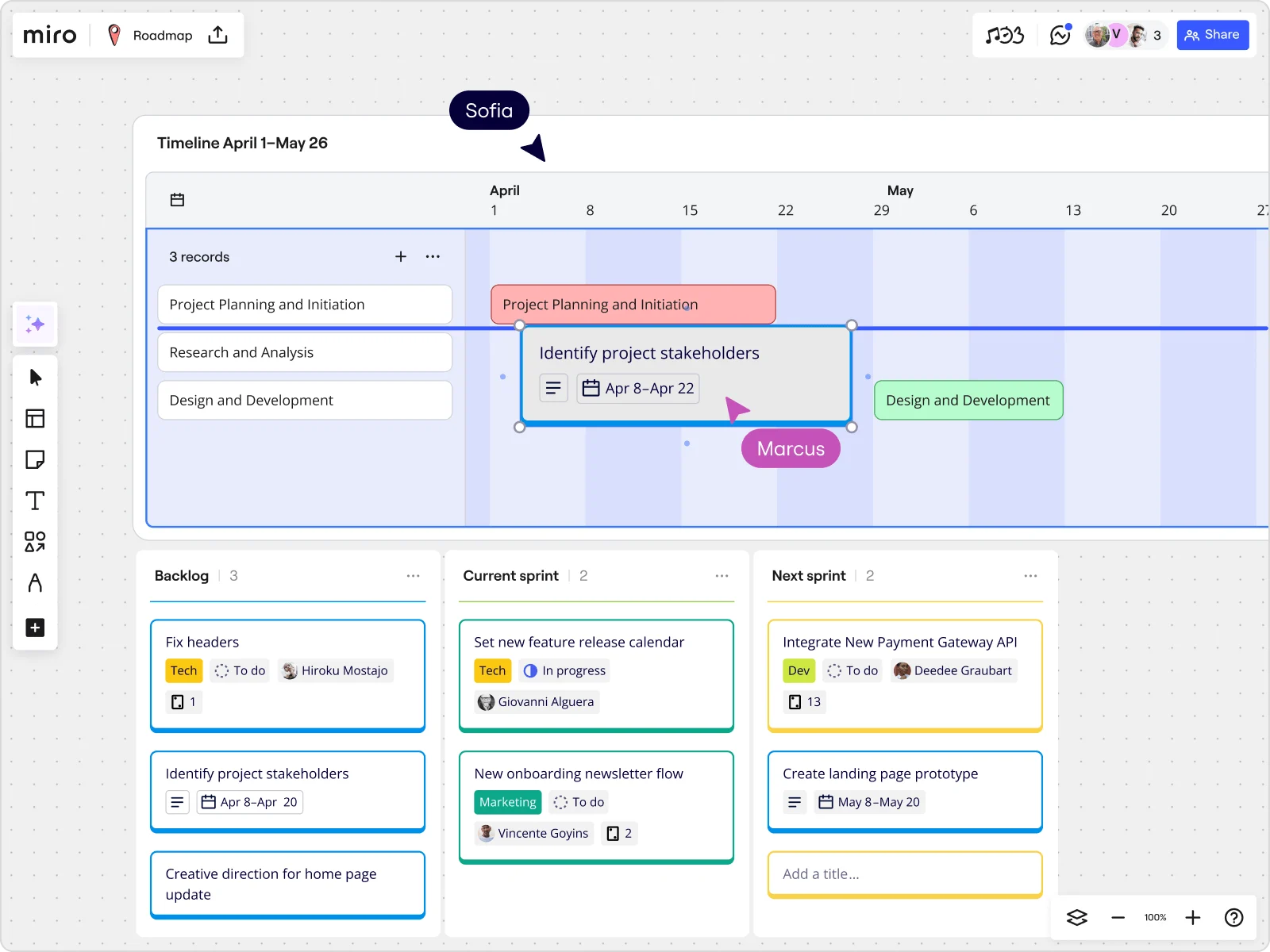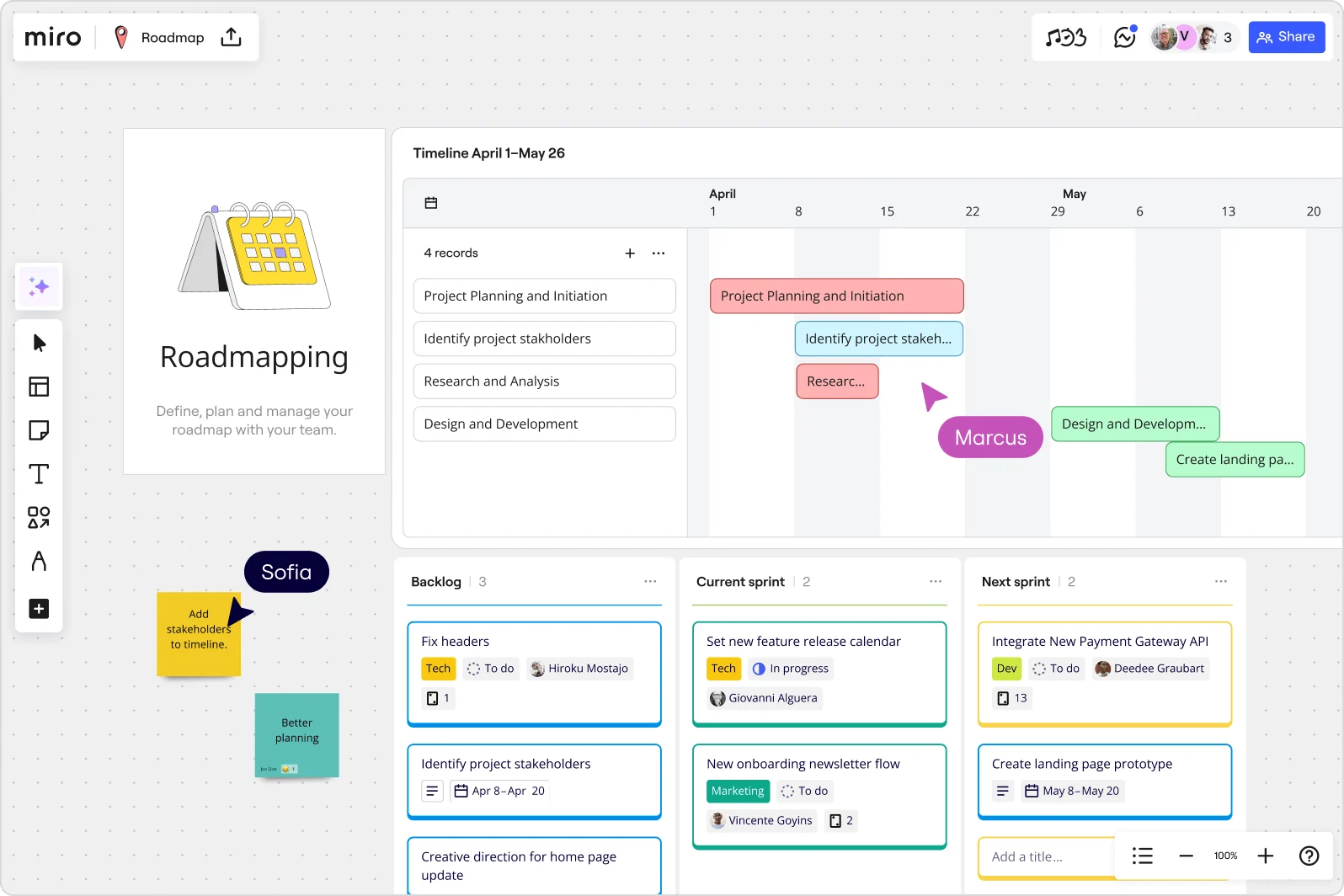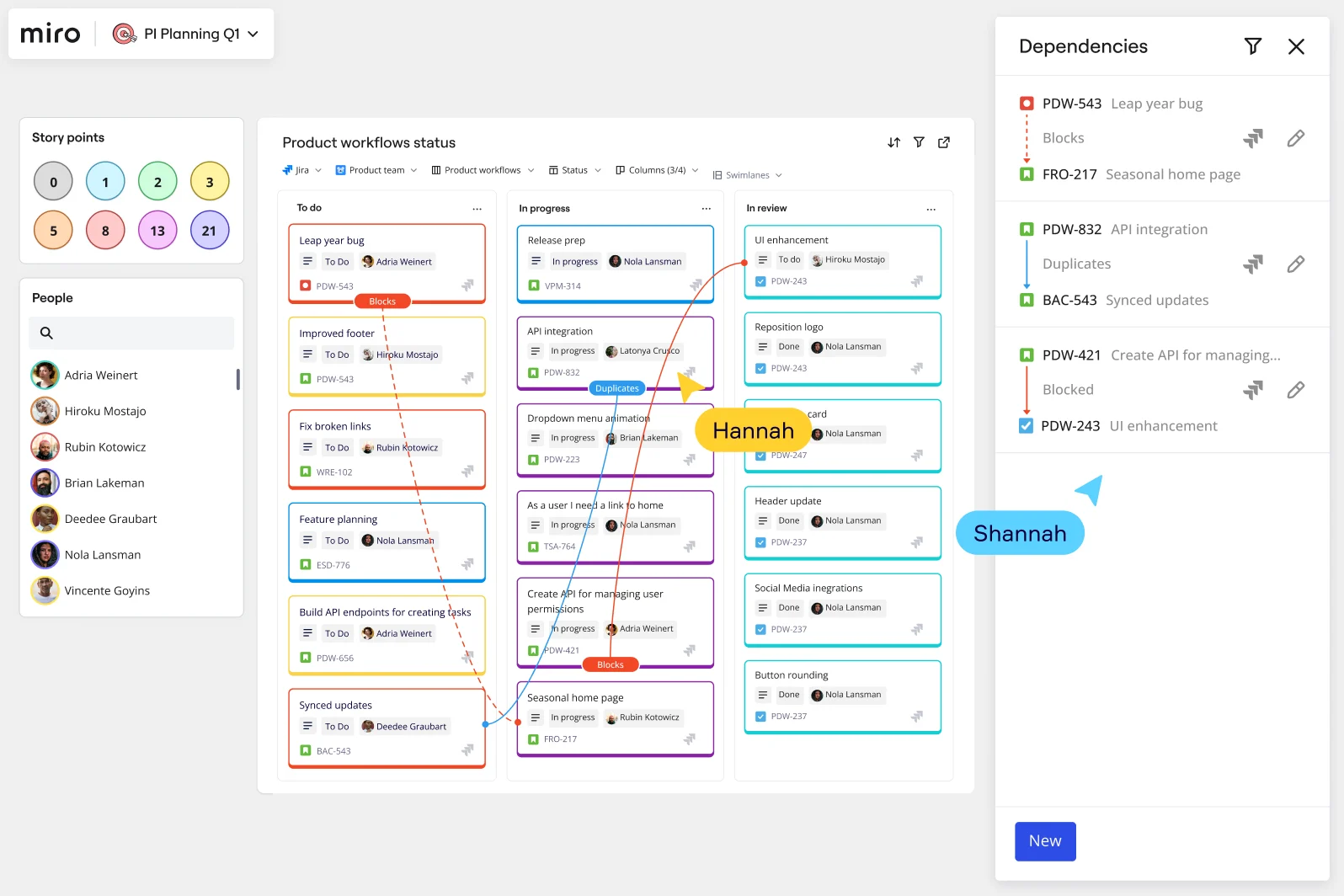
Table of contents
Table of contents
Understanding the product development process

Summary
In this guide, you will learn how to:
- Break down the product development process from idea to launch
- Validate ideas with customer needs and market research
- Apply best practices to reduce risks and improve outcomes
- Measure success with clear metrics and KPIs
- Visualize your workflow with a product development process flowchart
Try Miro now
Join thousands of teams using Miro to do their best work yet.
The product development process is a journey. It's a series of steps that transform an idea into a tangible product. But it's not just about creating something new. It's about understanding your customers, their needs, and how your product can meet those needs.
This guide will walk you through the product development process, from planning to delivery. We'll explore the stages, the importance of a structured approach, and how to visualize your journey with a product development process flowchart.
Whether you're part of a product development team, an agile team, or a design and UX team, this guide is for you. Let's get started.
What is the product development process?
The product development process is a structured approach to taking a product from an idea to launch. It combines planning, designing, building, testing, and marketing a product that meets a market need.
Understanding the product development process is crucial. It's more than just moving from one stage to another. Each stage serves a distinct purpose in creating a successful product.
A structured process guides you from ideation to the market. It helps you stay focused and ensure no critical steps are skipped, while allowing for flexibility and adaptations as needed.
Here’s a quick breakdown of a typical process:
- Ideation: Generate and refine ideas.
- Research: Validate ideas through market research.
- Planning: Outline strategies and resources.
- Prototyping: Create prototypes to test ideas.
- Development: Develop the final product.
- Testing: Ensure quality and functionality.
- Delivery: Launch the product to the market.
When executed effectively, the product development process can lead to innovation and customer satisfaction.

Customer needs and market research
Customer needs are at the core of product development. Understanding them sets the foundation for all subsequent stages. It's like having a compass guiding your product's journey.
Market research plays a crucial role. It helps validate product ideas and ensures your product fills a genuine market gap. It's not just about data. It's about insights that drive decision-making.
By prioritizing customer needs and leveraging market research, you can align your product with market demands. This reduces the risk of failure and enhances product acceptance.
What is the difference between product development and product discovery?
The key difference between product development and discovery is the timeline. Product discovery is when teams identify user needs, test ideas, and validate assumptions before anything is built. Product development occurs after product discovery, ensuring teams are building the product in the right way.
1. Product discovery: exploring and validating Ideas Product discovery is the phase that happens before any actual product is built. Its goal is to identify user needs, understand the problem space, and validate ideas. Teams ask questions like:
- What problem are we trying to solve?
- Who are the users, and what are their pain points?
- Is this solution viable and desirable in the market?
Discovery involves activities such as user interviews, market research, competitor analysis, and rapid prototyping. The purpose is learning and validation, not execution. By testing assumptions early, teams reduce the risk of building a product that no one wants.
2. Product development: building the right solution Product development begins after product discovery confirms that there is a real problem worth solving. Here, the focus shifts to execution, including designing, building, and launching the actual product. Development is about turning validated ideas into a tangible solution, ensuring the product works, scales, and delivers value.
Why do I need a product development process?
If you’ve been building the wrong products, delivering a poor user experience, or had difficulty scaling a product, it’s likely you need to revisit your product development process. You’ll also need to align a new product development process if you’re launching something completely new to ensure it doesn’t fail.
Implementing a strategic and thorough product development process helps to reduce risk and improve product outcomes to truly solve customer problems. Without it, your business will continue to waste time, misalign priorities, or launch products that fail to gain traction.
What are the product development process stages?
The product development process unfolds in distinct stages, each critical to transforming an initial idea into a successful product. Below, we explore the product development process steps, alongside some product development process examples to illustrate their importance.
1. Ideation
Ideation is where the journey begins. It involves brainstorming sessions and free-flowing creative thinking to generate a wide array of potential product ideas. This stage is about quantity over quality where no idea is too wild or insignificant.
Example: A tech startup might hold a brainstorming workshop to address a pain point in remote work. They use tools like Miro to map ideas, ultimately landing on the concept of a virtual coworking space platform.
2. Research
Once you have a promising idea, the next step is research. This involves conducting market analysis, understanding customer needs, and evaluating competitors. The goal is to ensure the idea has value, demand, and a unique position in the market.
Example: For the virtual coworking platform, the team surveys remote workers and freelancers to identify their challenges with isolation and productivity. They also analyze competitors to understand gaps in existing solutions.
3. Planning
In the planning stage, teams create a strategic roadmap. This involves setting clear goals, defining roles, allocating resources, and establishing timelines. A detailed plan ensures everyone stays aligned and focused on shared objectives.
Example: The startup drafts a six-month roadmap for their coworking platform. They assign tasks like UX design, marketing strategy, and software development, ensuring milestones are achievable.
4. Prototyping
Prototyping transforms abstract ideas into tangible models. These can be wireframes, mockups, or working models that simulate the final product. Prototypes allow for early feedback and iterative improvement, especially when a small target group is used to test it..
Example: The team develops a basic prototype of the virtual coworking space, including key features like a video room and collaborative tools. They share it with a small focus group for initial feedback.
5. Development
The development stage is where the product truly takes shape. Engineers, designers, and developers work together to build the product according to specifications. This phase demands precision, collaboration, and a focus on quality.
Example: Developers code the coworking platform, integrating feedback from the prototype stage. They ensure the software is scalable and user-friendly, using Agile methodologies to maintain flexibility.
6. Testing
Rigorous testing ensures the product performs as intended and meets user expectations. Testing can include usability tests, quality assurance, and stress tests to identify and resolve any issues.
Example: The team invites beta users to test the coworking platform. They gather insights on functionality, usability, and reliability, making adjustments based on user feedback.
See how Miro supports with collaborative testing: https://www.youtube.com/watch?v=4uzeEa6Gqqc&list=PLmiHe0R4hbzSnBSW_a3T-THthtkUIX5qv&index=19
7. Delivery
Delivery is the culmination of the development process. With a comprehensive go-to-market strategy, the product is launched. However, the journey doesn’t end here. Post-launch feedback and analytics guide future iterations.
Example: The startup launches the coworking platform with a targeted marketing campaign. After the launch, they monitor user engagement metrics and collect reviews to inform future updates.
The product development process stages provide a helpful framework, but they are not set in stone. The process is often iterative, allowing teams to adapt, revisit, or reorder stages as needed.
For example, you might return to the research phase after testing reveals new insights or refine your prototype during development. Flexibility is key. Every product journey is unique, and success often comes from embracing a dynamic approach that adjusts to challenges and discoveries along the way.
Best practices for a successful product development process
Crafting successful products means following best practices throughout development. Start by fostering a team culture of transparency and open communication. This encourages collaboration and ensures everyone works towards shared objectives.
Focus on a customer-centric approach. Understanding your user’s needs forms the foundation of effective product development. Consistently validate ideas against customer expectations and insights gathered from market research.
Iterate frequently to refine and improve. Incorporate feedback loops to address issues and enhance features. This adaptability ensures that the final product resonates with your target market.
Here are some best practices to keep in mind:
- Maintain clear and consistent communication.
- Prioritize user feedback and iterate on it.
- Align development goals with business strategy.
- Employ agile methodologies for flexibility.
- Foster collaboration across cross-functional teams.

How to measure success in the product development process
Implementing the product development process and carrying it through to a product launch is great, but how do you know if it’s been a success? Without clear metrics to measure against, your team may feel like they’re still in a cycle of guesswork.
Here are some of the key ways you can measure the success of your product development process.
Establish the right metrics
Tracking the success of your product development is only possible when you have defined key metrics to measure against. Consider tracking metrics like:
- Customer satisfaction scores (CSAT)
- Net promoter scores (NPS)
- User retention rates
- Time-to-market
- Iteration cycles
Listen to customer feedback
Never underestimate the power of customer feedback when working through your product development process. Continuously identify opportunities for improvement by:
- Carrying out regular surveys
- Monitoring product reviews
- Analyzing usage data
All of this information is super valuable when tracking your success. You can use everything you identify to meet the needs of your customers when the product finally launches, as well as inform the marketing strategy.
Identify KPIs
Maintaining alignment between your product development strategy and the product development process is key. This is why establishing well-defined KPIs (key performance indicators) is important. Your KPIs should match up to your wider business goals to successfully pinpoint areas of success and improvement.
Consider these as KPIs to get you started:
- Tracking market share
- Analyzing feature adoption rates
- Monitoring revenue growth
Real-world example: ASOS
The ASOS product and engineering teams were using many different tools for ongoing planning, posing a risk of misalignment and delays in product development.
Miro helped establish a unified planning practice that brought together over 60 Agile teams in one online workspace to align priorities and visualize dependencies.
By bringing teams together in Miro rather than using multiple tools, ASOS experienced:
- 71% more effective meetings
- ~50% less time spent on product planning
- 3.75 hours saved per Miro user per week
Read the full case study here.
Create a product development process flowchart in Miro
Visualizing the product development stages is crucial for team alignment. Flowcharts serve as a visual reference for all team members. This ensures everyone stays on the same page, reducing misunderstandings. Whether you're planning a new product or refining an existing one, a flowchart guides the journey.
Here's what you can achieve with Miro’s flowchart capabilities:
- Outline key product development stages clearly.
- Identify dependencies and potential bottlenecks early.
- Facilitate better communication through visual clarity.
- Engage stakeholders with an accessible overview.
Crafting a flowchart in Miro is both seamless and collaborative. Start for free now with one of our free flowchart templates or let the AI do the work with Miro's AI flowchart generator.
Product development process FAQs
What is an agile product development process?
Agile product development is where teams build products in small, testable increments called sprints. The difference here is that elements are delivered in stages rather than all at once. An agile product development process concentrates on collaboration, user feedback, and adaptability.
What is a PRD and why does it matter?
PRD stands for product requirements document, and this outlines what a product should do, including features, goals, user needs, and technical requirements. A PRD is a critical tool for aligning product, design, and engineering teams so they are all working toward the same vision.
How can I use the 80/20 rule in product development?
The 80/20 rule, or Pareto Principle, suggests that 80% of value comes from 20% of features, which can help to prioritize features during the product development process.
How can I ensure quicker time to market with the product development process?
The product development process can help to get your product to market quicker by reducing the time spent on time-consuming tasks. You can do this by:
- Building MVPs first
- Using agile frameworks
- Gathering early user feedback
- Using collaboration tools to align stakeholders and reduce handover delays
Can I customize Miro boards for each stage of the product development process?
Yes! Miro boards are fully customizable and infinite. You can develop unique spaces for idea generation, research, design, roadmapping, sprint planning, and retrospectives - all supporting the product development process.
You can customize with different templates, layouts, colors, fonts and more, making your board completely unique to you.
Can Miro be integrated with other product development tools?
Miro integrates with many different product development tools including Jira, Confluence, Figma, Slack, Google Drive, Notion, and more. You can connect workflows, sync data, and streamline communication across your entire tech stack.
Can my team collaborate with me throughout the product development process in Miro?
Of course! Miro is built for real-time collaboration and asynchronous working. Team members of your choosing can co-edit boards, comment on items, tag one another, and leave feedback using a variety of tools. These include comments, live cursors, and Talktrack.
Author: Miro Team
Last update: October 14, 2025